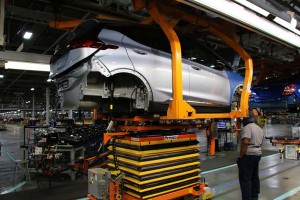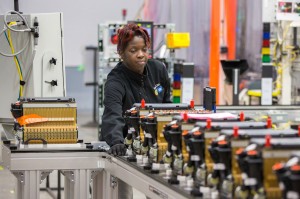
Automakers are finding ways to use the electric vehicle batteries after the cars they go into reach the end of their lifespan.
What happens when that battery-electric vehicle is finally ready to retire? Its sheet metal, glass and a number of other materials will likely be recycled, as automakers struggle to reduce the amount of vehicle scraps that go into landfills.
But those big batteries could remain productive for a number of years, automakers have come to believe, even after the vehicle is off the road. A number of companies, including General Motors and the Renault-Nissan Alliance, are studying ways to use battery packs that come out of hybrids, plug-ins and pure battery-electric vehicles.
As with the lithium-ion batteries in cellphones and other consumer devices, those used in vehicles do lose some of their capacity as they age and go through repeated charge/discharge cycles. But automakers intentionally use chemical formulations – along with thermal management systems – to minimize this degradation. So, according to Pablo Valencia, a battery expert at GM, they may retain as much as 80% of their capacity when the vehicle itself is ready for the rust heap.
GM has been working with a number of utility companies to explore opportunities, most of the attention focused on creating “farms” or clusters of used lithium battery packs removed from vehicles like the Chevrolet Volt plug-in hybrid. These could kick in when the grid goes down, or when demand exceeds capacity, something that might result in a brown-out or eventual blackout.
Proponents see this approach as a way to also level out the supply of energy from wind turbines and solar cells, which are at the mercy of changing weather conditions and the daily setting of the sun.
GM is already using five old Volt batteries to back up the two wind turbines and a solar array that went into operation at the Enterprise Data Center at the company’s Milford (Michigan) Proving Grounds in June 2015.
(Musk tells shareholders Tesla will need 10 or 20 assembly plants. For the story, Click Here.)
But Renault-Nissan is reportedly ready to bump things up by several orders of magnitude. According to a Reuters report, the Euro-Japanese alliance is working on plans for a 100-megawatt power storage plant that will go into operation somewhere in Europe.
A Renault spokesperson confirmed to Reuters that the company is “working in partnership with (energy storage specialist) The Mobility House on several programs including a major energy storage project that is currently still in the study phase.”
Reuters reports the project would have enough capacity to handle 120,000 homes and displace a conventional, fossil fuel-fired generator. Possible cites could include Germany and Netherlands, both with large installed bases of renewable, if inconsistent, energy sources.
The two auto partners have reason to be interested in such a project. During the past decade, Renault and Nissan have collectively produced more plug-based vehicles than any other manufacturer, including the Leaf battery-electric vehicle. And a growing number of those will be ready for scrappage in the coming years.
(Click Here to see more about Daimler’s new $1.15 billion EV battery plant.)
If any maker could need a way to reuse old batteries in the near future, it will be Tesla, however. The automaker produced roughly 100,000 of its Models S and X electric vehicles last year, and the company is targeting annual volumes of 500,000 and more starting next year as the production of the new Model 3 sedan ramps up.
Tesla has already teamed up with the California Public Utilities Commission and Southern California Edison to set up a 100 mW battery storage system near Los Angeles.
In Tesla’s case, the company will be looking to create storage systems for both old batteries, as well as new ones being produced at the Gigafactory lithium-ion plant near Reno, Nevada.
Other automakers looking at “second-life” applications include the German Big Three: Daimler, BMW and Volkswagen, as well as Chinese EV maker BYD.
(To see why GM’s Reuss is predicting the company will build the first profitable EV, Click Here.)
“We forecast the combined market for electric passenger vehicles, electric buses and battery storage to increase eight-fold to over $200 billion by 2020, a five-year compound annual growth rate of more than 50%,” Berenberg Equity Research analysts told Reuters.

